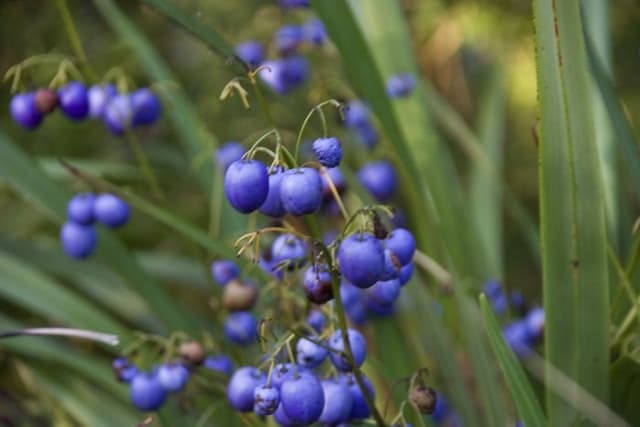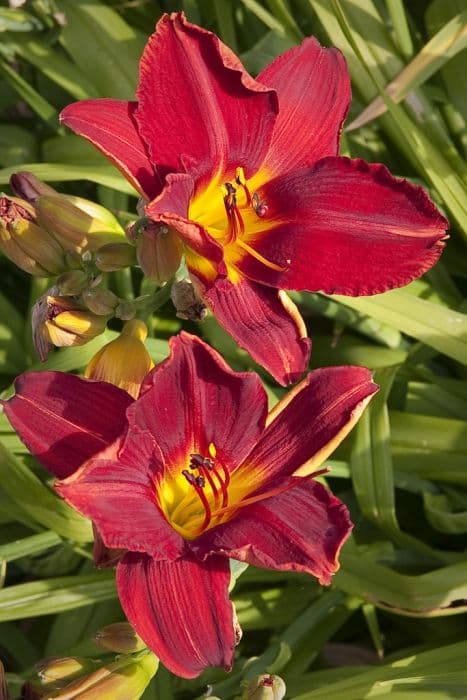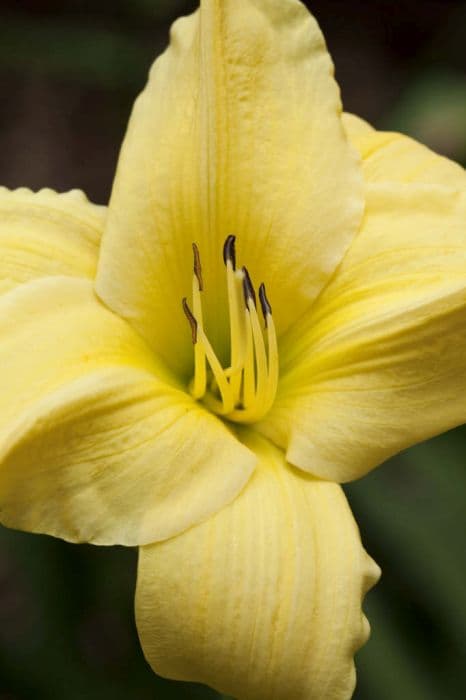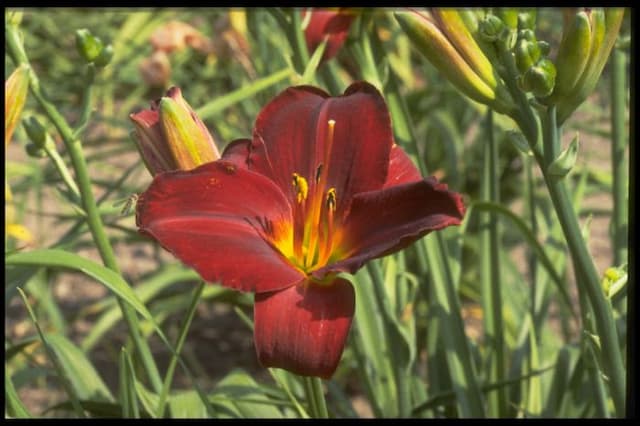Daylily Hemerocallis 'Catherine Woodbery'

ABOUT
The Hemerocallis 'Catherine Woodbery' is commonly known as the daylily "Catherine Woodbery". This plant is highly admired for its striking flowers that exhibit a delicate pale lavender-pink hue. Each bloom is characterized by its soft, rounded petals which gracefully curl back as if to display the yellow-green throat at the center of the flower. The blossoms are large and showy, often creating a dramatic effect in the garden when they are in full bloom. The foliage of the Catherine Woodbery daylily is also quite pleasing to the eye, with long, arching leaves that have a grass-like appearance. These leaves form dense clumps, providing a lush green backdrop which further accentuates the light-colored flowers. The plant blooms profusely, often producing numerous flowers on each stem, which emerge over an extended period during the flowering season. The overall impression of the Hemerocallis 'Catherine Woodbery' is one of grace and softness, with the pastel flowers offering a sense of serenity and simplicity. The captivating beauty of this daylily makes it a popular choice for borders, flower beds, and as an accent in perennial gardens.
About this plant
 Names
NamesSynonyms
Daylily, Catherine Woodbery Daylily.
Common names
Hemerocallis 'Catherine Woodbery'.
 Toxicity
ToxicityTo humans
The daylily (Hemerocallis 'Catherine Woodbery') is generally considered non-toxic to humans. Many parts of the daylily are actually edible and sometimes used in culinary applications. However, it's important to note that plant sensitivity can vary from person to person, and consuming any plant matter may cause a reaction in individuals with specific allergies or sensitivities. If someone does have an allergic reaction after ingesting daylily, they may experience symptoms such as gastrointestinal upset, skin rash, or difficulty breathing. If these or any other concerning symptoms occur, medical attention should be sought.
To pets
Daylilies, including Hemerocallis 'Catherine Woodbery', are toxic to cats. They contain compounds that can cause feline hemolytic anemia if ingested, even in small amounts. Symptoms of daylily poisoning in cats can include vomiting, inappetence, lethargy, kidney failure, and possibly death if not treated promptly. If you suspect your cat has ingested any part of the daylily, contact a veterinarian immediately. Dogs are generally not considered to be at risk from daylilies, but individual dogs may experience mild gastrointestinal upset if they consume plant parts.
 Characteristics
CharacteristicsLife cycle
Perennials
Foliage type
Deciduous
Color of leaves
Green
Flower color
Lavender
Height
3 feet [0.91 meters]
Spread
2 feet [0.61 meters]
Plant type
Herb
Hardiness zones
3-9
Native area
Asia
Benefits
 General Benefits
General Benefits- Easy to Grow: Daylily 'Catherine Woodbery' is known for being low-maintenance and easy to care for, making it an ideal choice for beginner gardeners.
- Drought Tolerant: Once established, this daylily can withstand periods of low water availability, which is beneficial in arid climates or water-restricted areas.
- Pest Resistant: It is generally resistant to pests, reducing the need for chemical treatments.
- Attracts Pollinators: The flowers attract butterflies and bees, which are beneficial for pollinating garden plants and the local ecosystem.
- Variety of Uses: Works well in borders, mass plantings, and as a ground cover, providing flexibility in garden designs.
- Colorful Blooms: Offers abundant and colorful blooms that enhance the visual appeal of a garden or landscape.
- Adaptable: This daylily can adapt to a variety of soil conditions, although it prefers well-draining soil.
- Long Blooming Period: Has a long flowering season, often blooming for several weeks, which extends the colorful impact in the garden.
- Perennial Growth: As a perennial, it returns year after year, providing continuity in the garden’s design.
 Medical Properties
Medical PropertiesThis plant is not used for medical purposes.
 Air-purifying Qualities
Air-purifying QualitiesThis plant is not specifically known for air purifying qualities.
 Other Uses
Other Uses- The petals of daylilies, including Hemerocallis 'Catherine Woodbery', can be used to create a natural plant dye for fabrics, yielding colors that vary from yellow to pink, depending on the mordant used.
- Daylily blooms can be included in floral water infusions to add a subtle flavor and aroma, as well as a touch of elegance to the presentation.
- Pressed daylily flowers can be used in craft projects such as handmade paper, bookmarks, or resin jewelry for their aesthetic value and texture.
- The sturdy leaves of the daylily can be woven into small baskets or decorative items when harvested and treated properly.
- As an educational tool, school projects often utilize daylilies to demonstrate parts of a flower or to observe plant growth and development over time.
- Daylily flowers can be used as natural confetti at events such as weddings and parties, as they are biodegradable and less harmful to the environment than synthetic alternatives.
- In photography, daylilies provide a vibrant subject for practicing macro-photography and exploring concepts of light, shade, and color.
- The robust root system of daylilies can help with soil erosion control by stabilizing the ground on slopes and banks.
- Gardeners might use daylily plants as a living mulch to suppress weeds due to their dense foliage which can shade out competing plants.
- Hemerocallis 'Catherine Woodbery' can serve as a food source for pollinators like bees and hummingbirds, supporting local ecosystems.
Interesting Facts
 Feng Shui
Feng ShuiThe Daylily is not used in Feng Shui practice.
 Zodiac Sign Compitability
Zodiac Sign CompitabilityThe Daylily is not used in astrology practice.
 Plant Symbolism
Plant Symbolism- Longevity: Daylilies, the common name for Hemerocallis 'Catherine Woodbery', are symbols of a long life. The genus name Hemerocallis comes from the Greek words for "day" and "beauty," reflecting the flower's brief lifespan, yet the plant continues to bloom for years, representing endurance over time.
- Motherhood: In Chinese culture, daylilies are associated with motherhood and the devotion of mothers due to their nurturing way of producing numerous blooms over a long period.
- Renewal & Hope: Each bloom of a daylily lasts for only one day, but new blooms appear each morning, which symbolize renewal, hope, and the inevitability of new opportunities.
- Forgiveness: The fleeting beauty of daylilies, with flowers that last but a day, is often seen as a reminder to forgive quickly, letting go of grudges and being ready to start fresh each day.
- Caring Nature: Because daylilies are hardy and low maintenance, they are often a symbol of a caring nature and an easygoing attitude in the garden, signifying an ability to take life's challenges in stride.
 Water
WaterThe daylily, commonly known as Catherine Woodbery, should be watered deeply about once a week, allowing the soil to become moist but not waterlogged. During the active growing season in spring and summer, especially in dry conditions, it may require watering twice a week. Aim to provide about one gallon of water per plant for each watering session, ensuring that the water reaches the roots rather than just wetting the surface. Decrease watering frequency as the plant goes dormant in fall, and during winter, water only if the soil is very dry.
 Light
LightDaylilies, such as Catherine Woodbery, thrive in full sun to partial shade. The ideal spot for them is an area that receives at least six hours of direct sunlight daily. However, they can also perform well in light shade, particularly in hot climates where some respite from the intense afternoon sun can prevent foliage from scorching.
 Temperature
TemperatureDaylilies like Catherine Woodbery can tolerate a wide temperature range, but they grow best when daytime temperatures are between 60 and 75 degrees Fahrenheit. They can survive minimum temperatures down to about -20 degrees Fahrenheit and maximum temperatures up to 90 degrees Fahrenheit. For optimal growth, avoid prolonged exposure to extremes beyond these limits.
 Pruning
PruningPrune daylilies like Catherine Woodbery to remove spent flower stalks and to tidy the plant's appearance. Deadheading, or removing the faded flowers promptly, can also encourage reblooming. Cut back the foliage to the ground in late fall after it has yellowed and died back, which will help reduce the chance of disease and improve the plant's vigor the following season.
 Cleaning
CleaningAs needed
 Soil
SoilThe Daylily 'Catherine Woodbery' prefers well-drained soil enriched with organic matter, with ideal pH ranging from 6.0 to 6.5. To create the best soil mix, combine loamy garden soil, compost, and a bit of sand to ensure good drainage.
 Repotting
RepottingDaylilies, such as 'Catherine Woodbery', do not require frequent repotting and are generally repotted every 3 to 5 years to rejuvenate the soil and divide the clumps if necessary.
 Humidity & Misting
Humidity & MistingDaylilies like 'Catherine Woodbery' are quite adaptable but prefer average to slightly higher humidity levels. They do not require special humidity conditions and thrive in outdoor garden settings where humidity naturally fluctuates.
 Suitable locations
Suitable locationsIndoor
Ensure bright light and good air circulation for Daylilies indoors.
Outdoor
Plant in sun to partial shade, water regularly, and maintain soil moisture.
Hardiness zone
3-9 USDA
 Life cycle
Life cycleThe life of Hemerocallis 'Catherine Woodbery', commonly known as the Daylily 'Catherine Woodbery', begins with germination from a seed or propagation from division of a mature plant. The young plant establishes itself with a clump of grass-like foliage and develops a root system. As it matures, it forms multiple green, strappy leaves and sturdy stems, known as "scapes," which rise above the foliage. The next stage sees the development of buds that unfurl into large, trumpet-shaped, soft lavender-pink flowers, typically blooming in early to mid-summer. After pollination, the flowers produce seed pods if conditions permit, but many gardeners remove the spent blooms to encourage reblooming and maintain plant vigor. The plant eventually enters a period of dormancy in late fall or winter, depending on the climate, only to restart its cycle with new growth when conditions become favorable in spring.
 Propogation
PropogationPropogation time
Early Spring
Propogation: Hemerocallis 'Catherine Woodbery', commonly known as the Daylily, is best propagated by division, which is the most popular and effective method for this perennial plant. Propagation by division should ideally be done in early spring or after the flowering period in late summer to early fall. To propagate Daylilies by division, you need to dig up the plant clump, taking care not to damage the roots. Using a sharp, clean spade or knife, separate the clump into smaller sections, each with at least 3 to 4 fans of leaves and a portion of the root system. Once divided, replant each section at the same soil depth as before, spacing them about 18 to 24 inches (45 to 60 centimeters) apart to give them room to grow. After replanting, water the new divisions thoroughly to help them establish in their new locations. This method helps to rejuvenate older clumps, encourages vigorous growth, and provides a simple way to multiply the beautiful Daylilies in your garden.









